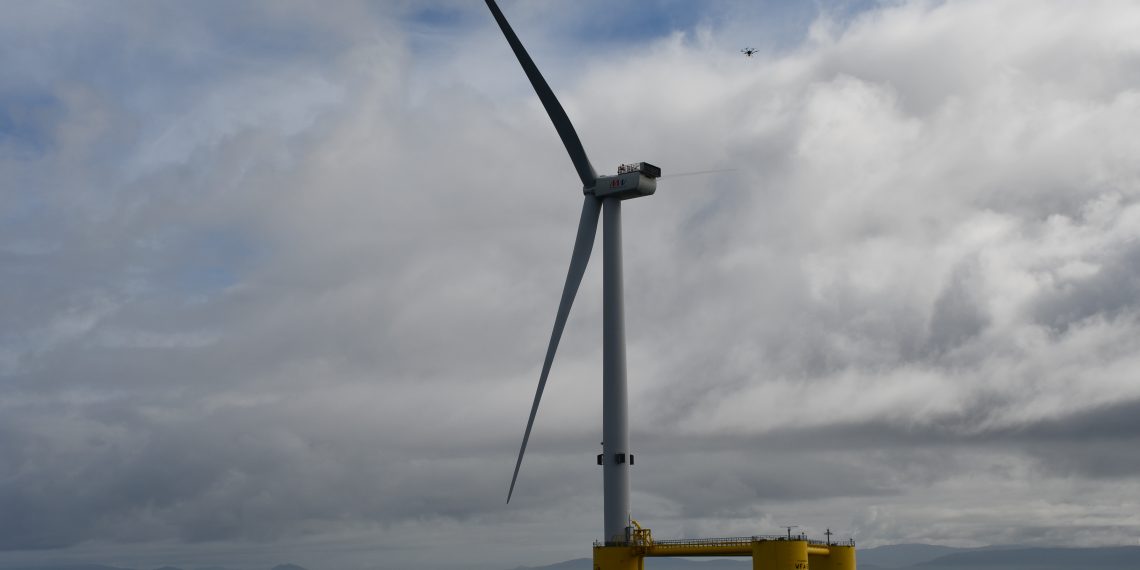The first offshore floating wind farm to be installed off the coast of Europe was the scene of an unprecedented demonstration: two autonomous vehicles were deployed simultaneously for inspection and maintenance operations on an offshore wind farm with floating foundations.
This significant achievement, carried out at WindFloat Atlantic, located off the coast of Viana do Castelo, was the first demonstration of its kind to take place at an Atlantic offshore wind farm with floating foundations, and it could change the future of maintenance operations in the renewable energy industry by enabling safer and faster interventions. The technology also aims to reduce operating costs.
The ATLANTIS project, led by INESC TEC, with the participation of EDP NEW and the support of other technological partners, has completed the first round of tests with autonomous robots on a floating offshore wind platform. As part of this project, a test platform (Atlantis Test Center) was created in Viana do Castelo to demonstrate autonomous robotic technologies and solutions – underwater, surface, and aerial – which are essential for the inspection and maintenance of offshore wind farms. Recently, the inspection and maintenance of autonomous robotic vehicles for visual inspection was validated for the first time in an offshore wind farm located in the Atlantic with floating structures.
The demonstration took place at Ocean Winds’ WindFloat Atlantic wind farm, which is the only offshore wind farm operating in Portugal and the first floating wind farm to be installed off the coast of Europe, with three turbines and the capacity to produce 25.4 MW – enough to generate energy for 25,000 families a year. The team tested the use of robots for inspection and monitoring operations. Specifically, using autonomous vehicles was successfully demonstrated for visual and thermographic inspections and assessments of the structure using multi-domain maps.
“This is a significant accomplishment, not only because we were the first in the world to demonstrate robots operating autonomously and simultaneously in a pre-commercial floating wind farm but also because we have opened the doors for robotics and artificial intelligence to play a leading role in inspecting and maintaining this type of critical infrastructure,” explains Andry Maykol Pinto, a researcher at INESC TEC . He adds that this demonstration proves the fundamental role that the Atlantis Test Centre plays in the future of robotic maritime operations.
With the establishment of the first European Center for validating robotic solutions in a natural environment that is open to all national and international institutions, Portugal has successfully taken a leading position in the development of advanced automated technology for the renewable energy sector, specifically in the maritime field,” explains the project coordinator.
RAVEN and NAUTILUS are two examples of the autonomous robotic solutions available at the Atlantis Test Center. These can be used for aerial and underwater inspection tasks of several crucial components, namely the mooring lines, the foundations, the floating structure and the turbine. RAVEN, a drone capable of making, for example, visual, thermal and three-dimensional representations of the entire turbine, and NAUTILUS, an autonomous vessel that is equipped for multi-domain inspection and monitoring. Both robots are prepared to operate with high autonomy in the Atlantic Ocean, thus making infrastructure maintenance safer and more efficient.
João Formiga, Director of Renewable Energy Technologies at EDP NEW, recalls that the success of this test will allow, in the long term, the development of modern robotic solutions with great potential for commercial exploitation by the entire offshore wind energy value chain.
“The ATLANTIS project is a cutting-edge project focused on the future, and this demonstration will act as a driving force for the shift towards more sustainable and resilient offshore energy solutions. The use of autonomous vehicles is expected to lower Operations and Maintenance (O&M) expenses by 20% while also improving energy production reliability. By overcoming technological barriers, we are contributing to the long-term sustainability of the sector.”

This milestone has been reached at a crucial time when Portugal is preparing to start phased auctions as part of its plan to reach 10 GW of offshore wind power capacity.
Furthermore, in addition to leveraging the development of robotic solutions for the sector, the ATLANTIS project contributes to breaking down technological, legal and regulatory barriers, increasing trust between technology developers, end users and wind farm owners – obstacles that have, until now, impacted the use of robotics in current O&M methodologies.
The European project ATLANTIS – The Atlantic Testing Platform for Maritime Robotics: New Frontiers for Inspection and Maintenance of Offshore Energy – is funded by the European Union’s Horizon 2020 Program.
The researcher mentioned in this news piece are associated with INESC TEC and UP-FEUP.




 News, current topics, curiosities and so much more about INESC TEC and its community!
News, current topics, curiosities and so much more about INESC TEC and its community!